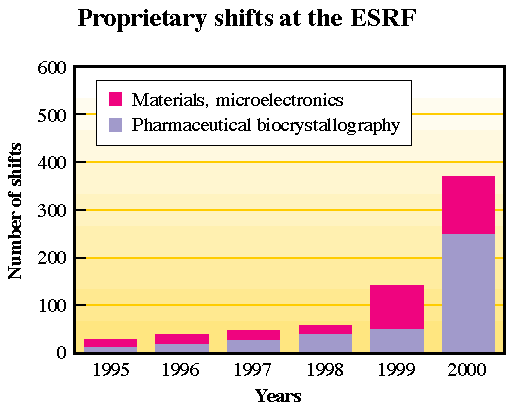Introduction
The year 1999 was marked by a change in the ESRF's policy for applied and industrial activities. Instead of trying to initiate industrial collaboration concerning all the domains and techniques as in previous years, a special effort was focussed on half a dozen industry-related projects. This effort was supported by the hiring of an engineer and a scientist whose activities are not only directed towards data collection but also to processing and analysing the data for the industrialists. This initiative permitted the opening of a more comprehensive analytical service.
Protein crystallography data collection is still the main industrial proprietary activity at the ESRF, and it represents about half of the overall beam time purchased by companies (see graph below). The systematic scheduling of measurement slots (on BM14 and ID14 beamlines) for industrialists now facilitates rapid access. In the near future, the program for automated data collection, presently being launched in collaboration with the EMBL, will permit a decrease in the dead-time between two sessions of data collection on different samples. As a consequence, it should allow us to meet the need for greater rapidity due to the increasing demand for protein structures issuing from pharmaceutical companies and the genome project.
Microelectronics is the second major domain and advances in this area have been encouraged by the construction of beamline ID27 specifically designed for surface micro-contamination analysis on silicon wafers by total X-ray reflection fluorescence. The beamline was completed during 1999, as part of the MEDEA program, and it should receive industrial customers from July 2000 onwards. ESRF beamlines are also used for many other types of measurements related to microelectronics has illustrated here by two examples on the structure of molten silicon and the interface structure between two silicon wafers.
Demand for the technique of microtomographic reconstruction has increased significantly, due to technical improvements both in data collection and image processing, and, more importantly, to the launching of a complete service. Companies can now submit their samples by post and the full analysis is rapidly carried out by an engineer of the ID19 staff specially assigned to this task. Two typical illustrations, on polymer foam and metal alloys, are given in this section.
A similar type of service for strain-stress analysis of metallic pieces will perhaps be offered to companies in the near future. The new diffractometer from the Risø Institute is now operational on ID11 and the high energy beams available on ID15 permit the analysis of bulk samples. This is illustrated by the contribution on residual stress.
The growing interest in powder diffraction is due to the high quality of the patterns, to the ability to follow processes in real-time cf. the contribution on intermetallic-ceramic synthesis and even to the application in situ of extreme pressures and temperatures cf. the contribution on the crystallisation of cubic boron nitride. A new service for pharmaceutical drug characterisation using the high resolution powder data on ID11 and BM16 should start at the end of the year 2000.
Our industrial collaborators also take advantage of many other techniques, including absorption spectroscopy and micro-analysis. Here the former has been used for the characterisation of a metallic catalyst and the latter has been used in the project of microdiffraction on human hair.
This new policy probably accounts for the doubling of the quantity of beam time that was purchased during 1999 by companies with respect to 1998. It has now reached 1.5% of the allocated beam time, but this value is still much smaller than the percentage of applied research that is carried out through the free-of-charge peer-reviewed access (about 20% to 25%). It is worth mentioning that the applied activity has been acknowledged officially at the ESRF, with the creation of the review committee section "Materials Engineering and Environmental Matters".




